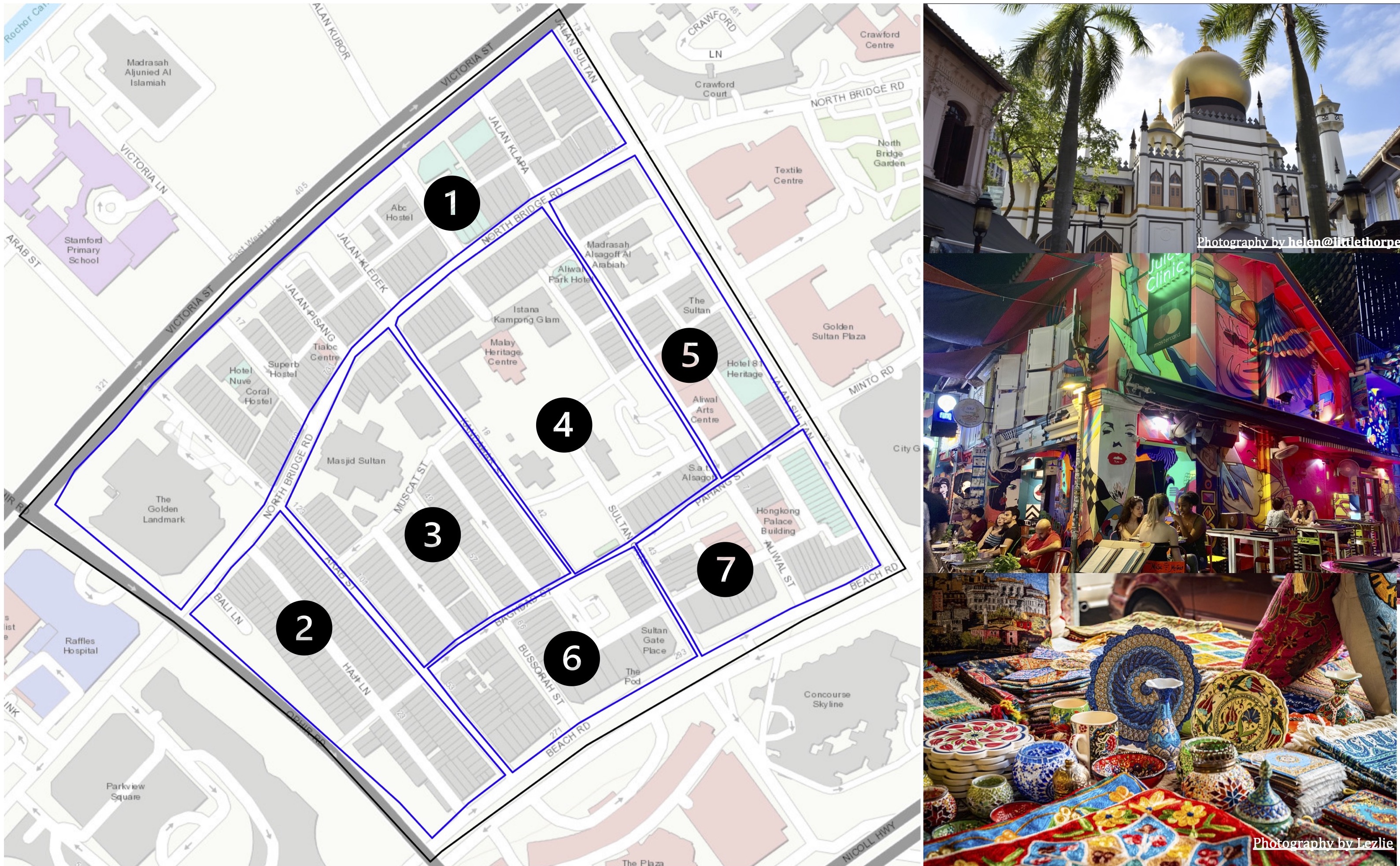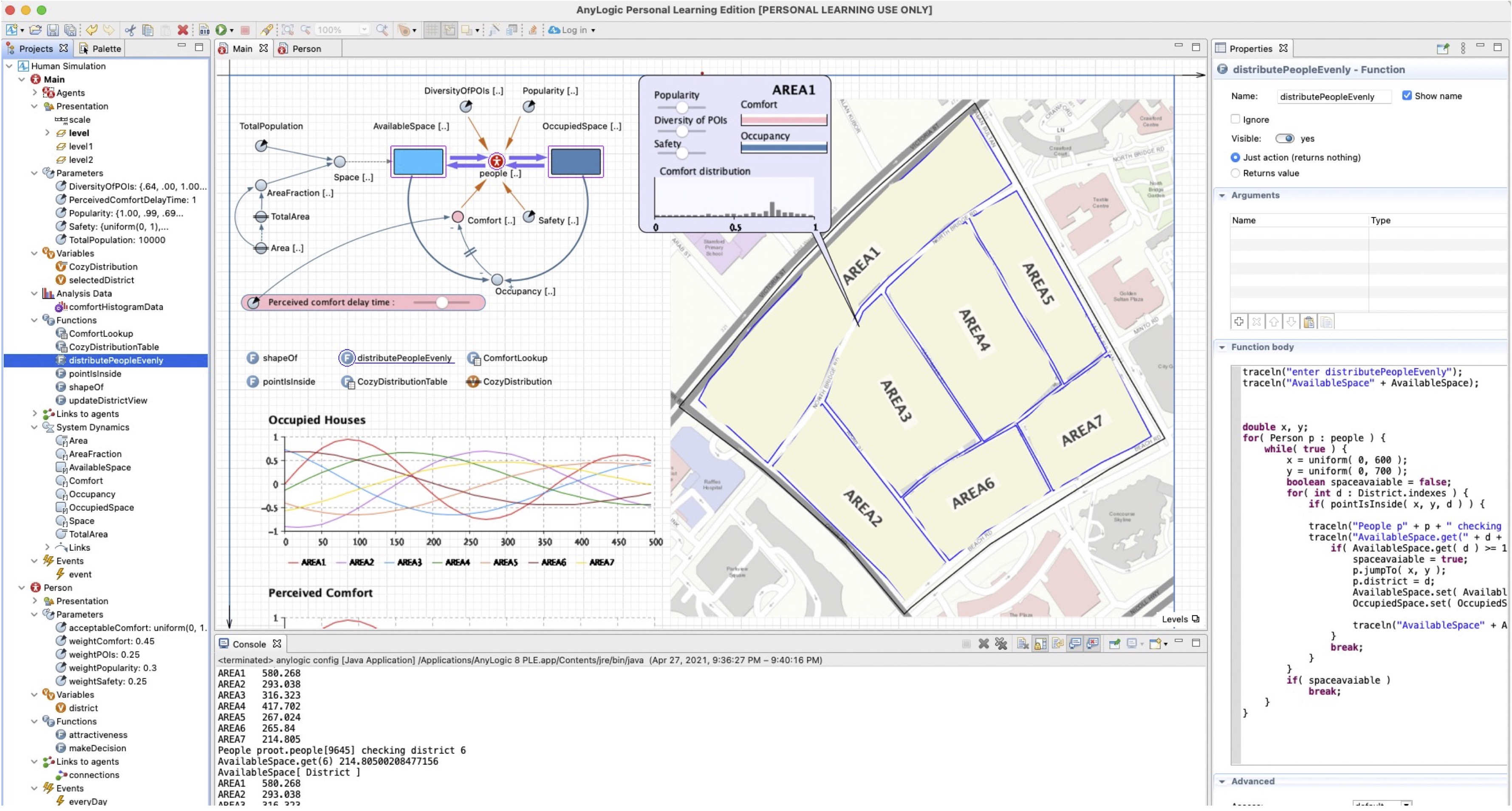Urban vitality
Human mobility simulation - Investigating the impact of urban vitality indicators on human movements
Urban vitality has long been a focus for researchers in Geography and Urban Planning, which is generally referred to the people and their activities in the space. It plays an essential role in evaluating urban development and has invisibly influenced the people and the society from the perspectives of the public health and safety, socioeconomic development, space quality and so on. People, particularly city dwellers who as the core of a city, interact with the space or the built environment in their day-to-day life, and their activities in built environment are generally used as the proxy for reflecting the urban vibrancy. Thus, uncovering and understanding human footprints left around the city is essential in evaluating urban vitality.
Traditional approaches for evaluating urban vitality are mainly focused on survey data. Although this sort of data has the advantage to collect more detailed socio-demographic characteristics of participants, it is generally labor-intensive, time-consuming, and has constraints in its sample size. With the proliferation of new emerged big data technologies, the study related to quantitatively analyzing urban vitality is able to go deeper at a much granular scale. Different indicators have been used for evaluating urban vitality.
However, the benchmark of indicators used to quantify urban vitality has not come with a consensus in the current state-of-the-art, and the driving mechanism of urban vitality based on the interaction among various indicators is yet under exploration. What kinds of indicators drive a city or a neighbourhood’s vitality? What is the relationship between them? Which indicator is more influential? What is the interaction between the indicators? How do the human footprints change under different drivers? These questions may link the urban vitality to the recent uptake of ‘15-minute city’ planning ideas, where all residents can access most of their daily needs (e.g., groceries, work, education, shopping, health, exercise, entertainment, etc.) within 15 minutes (up to 20 minutes), commuting from their own doorsteps by walking, cycling, or public transportation. This notion has been sharply discussed lately during the Covid-19 pandemic, as the pandemic has significantly restricted human movement, forcing people to stay at home and only go out for basic needs. As such, ushering in a new era of integrated urban fabric that combines most of the residents’ life essentials to each local community while maintaining the community vitality is promoted.
With this consideration in mind, the key objective of this study is to develop a model that investigates the impact of urban vitality indicators on human movements. To address this objective, the model should have the capability to portray the process of accumulation and feedback system, as well as the ability to monitor individual footprints. So, I design the model that combines both System Dynamic (SD) Model and Agent-Based Model (ABM) on AnyLogic (with Personal Learning Edition 8.7.3). The model is put to the test in application to a neighborhood named “Kampong Glam” in Singapore, and examine how do four indicators, namely Diversity of Point of Interests (POIs), Popularity, Comfort level and Safety, change human movements within the study area.
Study area
Kampong Glam is an ethnic enclave centred on busy Arab Street in Singapore (see Fig 1). Traditionally, it is the Muslim centre and home to mosques. There are various carpet shops, souvenir shops, accommodation, and middle eastern cuisine at reasonable prices. In recent years, the area has been a surge in boutique cocktail bars, nightclubs and restaurants. The abundant activities here have attracted not only locals throughout the city but also tourists around the world. It is no double a place with dense human movements, especially during weekends, holidays or peak tourist seasons. To compare the human footprints within the neighborhood in the model, I divide the study area into 7 areas as labelled on the map (see Fig 1).

Model design
The model is design to flexibly explore the impacts of different urban vitality indicators on the human movements. To this end, a basic model that combines both System Dynamic (SD) model and Agent-Based Model (ABM) is desinged to captures the feedback system as well as simulates individual movements, where the idea is inspired by a Social and Eco Dynamics Simulation model named ‘Agent Population and SD Housing' (A model of a city population dynamics developed by [Andre Rappaccioli](https://cloud.anylogic.com/model/2083dfe8-f259-4505-afe4-c7769d4052bd?mode=SETTINGS)). Figure 2 gives an overview of the model interface.

Four indicators, namely popularity, diversity of POIs, Comfort, and Safety are used in the model with certain assumptions.
- Assumption 1: The popularity is proportional to the number of social media users (i.e., Twitter users). The more users sent tweets in an area, the more popular that area is.
- Assumption 2: People are more likely to visit a place with more diverse POIs as they could have more options.
- Assumption 3: Simplify as a function of space occupancy. The more people in a space, the less perceived comfort in that space.
- Assumption 4: There is no significant difference of safety within the study area.
As output, the simulation produces a feedback system perceived comfort, as well as a map that shows the agent (human) movements among 7 areas based on the combined influence of four indicators.
System dynamic model (SD model)
A series of parameters that describe the dynamic system are shown below.
| Variable | Description |
|---|---|
| Area | A static array that records the real area of 7 areas. |
| Total Area | A constant that records the total area of 7 areas. |
| Area Fraction | A static array that records the fraction of each area to the total area |
| Total Population | A constant that indicates the initial number of agents (default = 10000) |
| Space | A static array that records the number of agents in each area based on the area fraction |
| Available Space | A dynamic array that records the available space that agents can move in. The initialized value is equal to space, but it changes over time during the simulation based on the human movements in each area. |
| Occupied Space | A dynamic array that records the occupied space by the agents. The initialized value is 0 and it changes over time during the simulation based on the human movements in each area. |
| Occupancy | A dynamic fraction of occupied space to the space of each area |
| Safety | A dynamic array that records the safety value in each area. The initialized value is randomly generate by a uniform distribution U(0.7, 0.9) as discussed in Data Preparation section. The value can be manually changed during the simulation by a tunable slider. |
| Popularity | A dynamic array that records the normalized popularity value in each area. The initialized value is measured based on real twitter data as discussed in Data Preparation section. The value can be manually changed during the simulation by a tunable slider. |
| Diversity of POIs | A dynamic array that records the normalized diversity of POIs in each area. The initialized value is measured based on actual POIs in each area as discussed in Data Preparation section. The value can be manually changed during the simulation by a tunable slider. |
| Comfort | A dynamic array that records the perceived comfort in each area based on the occupancy in each area as discussed in Data Preparation section. |
| Perceived comfort delay time | A tunable constant that indicates the delayed reaction of people. The delay time range from 10 minutes to 12 hours. |
Besides, there are three casual loops in the system (see Fig 3). The first causal loop is a balancing loop among the available space, occupied space, and occupancy. The second causal loop is a reinforcing loop between the occupied space and popularity, which is relatively straightforward. The third causal loop is a balancing loop among occupied space, occupancy, and comfort.

Agent-based model
The feedbacks obtained from the SD model are then sent to the Agent-Based Model, including the feedback of safety, popularity, diversity of POIs, and comfort of each area. The agents in the Agent-Based model own a series of properties (see Fig 4). Every hour, the agents received feedback from the SD model, evaluate the attractiveness of each area based on it, and then make their own decision regarding whether to move or not based on the decision tree (Fig. 4 right).

In summary, this study has demonstrated how the System Dynamic model and Agent-Based Model can be combined to investigate the influences of urban vitality indicators on human movements. The framework disclosed here utilizes the big data as well as other publicly available data to reproduce the actual environment in the model as much as possible. By using the integrated models, we can flexibly explore potential human movement patterns, which provides a solid foundation to study the roles of different indicators in urban vitality. However, the model introduced in this study is only an initial step towards this larger research agenda, and more complex rationalities or theories should be considered in future work to extend or improve the model.